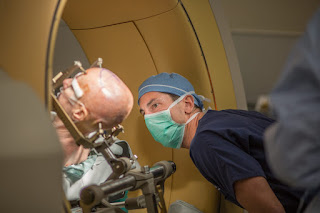Bethesda, MD – Scientists at the National Center for Complementary and Integrative Health (NCCIH) in Bethesda have announced the results of groundbreaking research that they believe confirms an ancient theory behind the effectiveness of acupuncture.

“Skeptics love to point out the fact that there is no proven mechanism of action when it comes to acupuncture,” NCCIH Director Helene Langevin explained. “Despite several millennia of proof that it works for a wide variety of medical conditions, like pain and infertility, they want to focus on a tiny issue like scientific implausibility instead of on the millions of satisfied patients. Well those skeptics won’t be able to poke any holes in this study! Do you see what I just did? Because it’s acupuncture.”
Ever since acupuncture was first discovered thousands of years ago when a Chinese peasant accidentally fell on a porcupine and noticed that his chi was 30% less stagnant*, medical professionals have assumed that it must work for some reason. According to Langevin, the study, which will be published next month in Online Publishing Module 453 – Medical Needle Shoving, finally solves one of acupuncture’s greatest mysteries. “Does it really matter where or even if the needles are inserted? Essentially, do specific and reproducible acupoints exist? Now we know. The chi, the meridians. All of it. It’s all true.”
In the NCCIH study, researchers inserted needles directly into the brains of volunteers in order to log any specific reactions unique to each location. A weak electrical current was also applied to each needle in order to add several paragraphs to the study’s conclusion section. Langevin is calling the results historic.
Not only does this research prove the existence of acupoints, but many of the subjects reported feeling relief after the procedure was completed and their skulls were stapled back in place. This supports the use of acupuncture for anxiety.
Although acupuncture is popular, and widely accepted as an evidence-based medical intervention by many physicians, some patients are not yet benefiting from this cutting edge application of ancient folk wisdom. With numerous health crises plaguing the country, one company is already working on submitting an application to the Food and Drug Administration for over-the-counter approval of an acupuncture kit developed for home use. While not meant to replace expert analysis for determination of which specific acupoints need unclogging, this could improve access to for millions of Americans.

The company is Battlefield Acupuncture Inc., a manufacturer of needles, seeds, and pressure application devices traditionally used by trained professionals. But what is home acupuncture? Is it safe in the hands of amateurs? Could the wrong person figure out a way to reverse the healing powers of acupuncture and use it for evil instead, perhaps causing chi to back up until a person literally explodes?
Acupuncture is an ancient form of modern healthcare that was discovered thousands of years ago when its secrets were transmitted into the mind of a Chinese peasant by a large black bird. It involves the insertion of thin stainless steel needles into highly specific points on the body that were initially mapped out by shoving needles into random spots and asking subjects’ if their livers felt stronger. These “acupoints”, now proven to exist beyond any doubt, are areas where chi, a mystical science energy that regulates human health, has become stagnant. Needle insertion into acupoints allows chi to flow freely, and is primarily used in cases of any medical problem in humans.
Some critics, like Kuang Zhu LAC, Chief of Pragmatic Acupuncture in the Health and Wellness division of Vic’s Day Spa and Pet Grooming Center in Baton Rouge, Louisiana, are worried that improperly performed acupuncture could result in serious adverse outcomes:
“We aren’t saying that every incidence of spontaneous human combustion is linked to the incorrect placement of acupuncture needles. But in some cases, there is a temporal relationship that is hard to explain otherwise.”
Battlefield Acupuncture, Inc. in early December announced that its acupuncture kits were granted expedited special review from the FDA to become an “over-the-counter (OTC) emergency treatment for known or suspected chi stagnation”. This would make them the first such devices to receive the fast-track review. Expedited special review means that the FDA plans to evaluate the submission within just a few months, and is reserved for when a treatment “is really popular with white people and Cleveland Clinic tweets about it.”
*There is an alternative hypothesis regarding the discovery of acupuncture which has gained in popularity over the past few decades. Proponents claim that a Chinese farmer found it just lying there in a crashed alien spaceship thousands of years ago.
Unpoking the Nonsense
Not a lot to add to this one. Acupuncture is silly and I like mocking it. I mean, it has everything: an implausible and ritualistic belief system, its own ridiculous pseudo-history, wildly inappropriate claims of health benefits, and widespread acceptance by everyone from the guy who cuts my hair to leading experts in a science and medicine despite being something some guy essentially just made up in the 1950s.
See Steve’s post from a couple weeks ago for a nice discussion of the problems with assumptions made regarding acupuncture’s history and the many limitations in the research so often held up as proof of its benefit. The bottom line is that acupuncture stands as likely the best example of a core weakness in the conceptualization and execution of evidence-based medicine, and in just how challenging it is for even intelligent and well-meaning people to maintain skepticism in the face of a decades-long systemic public relations campaign behind what is, in reality, a bunch of nonsense.
